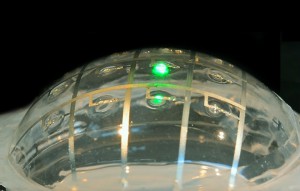
Scientists at EPFL in Switzerland have found a way to turn liquid metal, an alloy of gold and gallium, into a circuit that is flexible and can be stretched up to four times its original size.
Generally electronic circuits are very sensitive to bending and twisting because they are made from brittle metals, this can therefore lead to problems in several applications in the industry. The possibility of flexible electronic circuits could potentially solve a lot of these woes, and hopefully make for more reliable electronic products in the future.
Conductive tracks on a circuit board are usually hard printed on the board. But the circuit boards recently developed at EPFL are almost as flexible as rubber and can be stretched up to four times their original length and can be stretched a million times without cracking or interrupting the conductivity.
Looking to the future the potential applications are of a wide-range with everything from general electronics in vibrating machines (that can cause electronics to flex and bend if vibrations are not isolated properly), to more Sci-Fi inspired things like artificial skin on a robotic limb, skin on a soft robot, and electronic clothing.
“We can come up with all sorts of uses, in forms that are complex, moving or that change over time,” said Hadrien Michaud, a PhD student at the Laboratory for Soft Bioelectronic Interfaces (LSBI) and one of the study authors.
Extensive research has gone into developing an elastic electronic circuit. Components traditionally used to make circuits are rigid, so going against this convention is a real challenge. The scientists chose gallium as part of the alloy because it maintains good electrical properties and stays in its liquid state, even at room temperature.
The video below shows a couple of examples of the material’s flexibility. In lab tests the liquid metal circuits were put through punishing tests to prove it’s durability.
